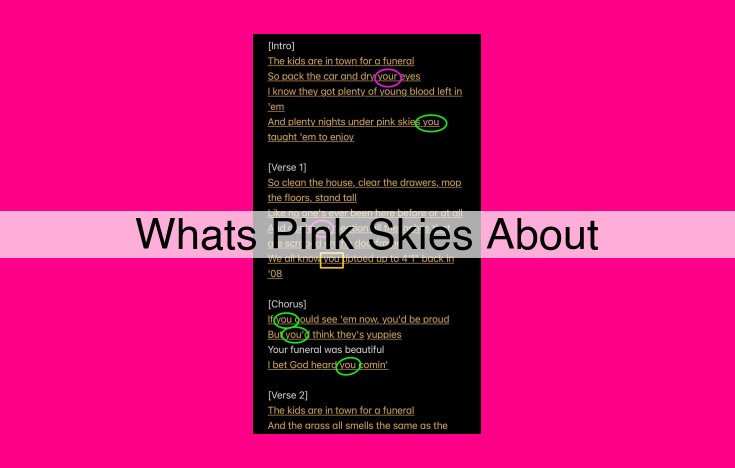Celestial Canvas: Unveiling The Enchanting Mystery Of Pink Skies

Pink skies, caused by the scattering of sunlight by atmospheric particles, occur under specific conditions. Aerosols, Rayleigh scattering, volcanic eruptions, and high-altitude clouds contribute to the phenomenon. Factors like low pollution, sunrise/sunset, mountainous areas, and polar regions enhance its visibility. Pink skies inspire art and scientific research, as they reveal atmospheric phenomena and influence artistic expression.
Atmospheric Phenomena Causing Pink Skies
The allure of pink skies has captured the imaginations of countless observers throughout history, from poets to painters. But what causes this ethereal hue to grace our skies?
One contributing factor is aerosols, tiny particles suspended in the atmosphere. These particles, ranging from dust to smoke, can scatter sunlight, creating a pinkish glow. Rayleigh scattering also plays a role. This scattering effect, responsible for the blue sky we see during the day, can also result in pink skies at sunrise and sunset when sunlight must travel a longer distance through the atmosphere.
Volcanic eruptions can inject vast amounts of ash and sulfur dioxide into the atmosphere, which can scatter and absorb sunlight, creating a lingering pink haze in the sky. High-altitude clouds, such as cirrus clouds, can also contribute to pink skies by scattering sunlight in such a way that the longer, redder wavelengths are more prominent.
In the absence of clouds, clear skies can still produce pink hues. This occurs when the sun is low on the horizon and its shorter, blue wavelengths are scattered away, leaving behind the longer, redder wavelengths that give the sky its pinkish glow.
Factors Influencing Pink Sky Occurrences
The enchanting spectacle of pink skies is often influenced by a symphony of atmospheric conditions and geographical factors. Understanding these factors unveils the secrets behind this captivating phenomenon.
Low Pollution: A Canvas for Pink Hues
When levels of air pollution are minimal, the atmosphere becomes translucent, allowing sunlight to penetrate more deeply. As the sun dips towards the horizon, its warmer, longer wavelengths (red, orange, and yellow) are scattered more effectively by larger particles in the air, such as dust and sea salt. This scattering process creates a soft, pinkish glow that suffuses the sky.
Sunrise and Sunset: The Theater of Pink
The dawn and dusk hours provide the optimal stage for pink skies. During these transitional periods, the sun’s light travels through a thicker layer of the earth’s atmosphere, further enhancing the scattering effect. As the sun descends below the horizon, the remaining sunlight is tinted a delicate rose or pink, casting a magical aura on the heavens.
Twilight’s Embrace: Amplifying the Pink
In the twilight zone, between sunset and darkness, the remaining sunlight interacts with the upper layers of the atmosphere, where Rayleigh scattering dominates. This process scatters shorter wavelengths of light (blue and violet) more effectively, while allowing longer wavelengths (red and pink) to permeate more freely, resulting in a glorious pink sky.
Mountainous Areas: Elevating Pink Horizons
Mountains provide an elevated vantage point for viewing pink skies. As the sun sets behind a mountain ridge, the sky glows in a pinkish hue, reflecting the indirect sunlight that has illuminated the mountain peaks. This phenomenon, known as alpenglow, can create a breathtaking display of pink and purple hues.
Arctic/Antarctic Regions: A Symphony of Pink and Ice
The polar regions offer a unique canvas for pink skies due to their clean air and vast ice fields. The minimize pollution in these regions allows sunlight to penetrate more deeply, while the reflective nature of ice further scatters the longer wavelengths of light, creating a spectacular pink sky.
Cultural and Scientific Aspects of Pink Skies
Pink skies, a captivating celestial spectacle, have left an enduring mark on our culture and ignited scientific curiosity.
Artistic Inspiration:
Impressionist painters, such as Claude Monet, were captivated by the ethereal beauty of pink skies. Their canvases captured the soft glow and ephemeral nature of these celestial wonders, evoking a sense of wonder and nostalgia.
Scientific Investigations:
Renowned organizations like NOAA, NASA, and ESA have dedicated research efforts to unraveling the mysteries of pink skies. Scientists have studied the scattering of light, atmospheric conditions, and volcanic eruptions to better understand these phenomena.
The Allure of Alpenglow:
Alpenglow, a stunning optical illusion, paints mountain peaks in rosy hues at sunrise and sunset. This effect occurs when sunlight is refracted and scattered by high-altitude water droplets or ice crystals, producing a breathtaking display. Pink skies and alpenglow are often intertwined, creating a captivating spectacle that leaves us in awe of nature’s beauty.